The Home of The Scroll & The Girl
Newly uncovered photos and corrections to history.
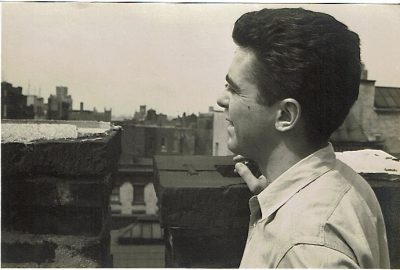
“Bill felt completely at home on the rooftops of Manhattan.”
Joan Haverty-Kerouac on Bill Cannastra
I knew I loved this guy! 🙂
.
To all in Beatlandia —
Pretty much nobody’s ever seen these buried Beat family photos in a hundred years of forever . . . but both The Beat Museum’s Jerry Cimino and I stumbled upon them within 24 hours of each other in the subterranean ancient Beat catacombs with flashlights in a corner-turning Spinal Tap lost moment of surprise!!
As a refresher — Bill Cannastra is probably best known as the source of the paper Jack Kerouac used to write the scroll version of On The Road, and as the person who was best friends with a young Joan Haverty, who lived in the loft following Bill’s tragic death trying to climb out the window of a moving subway car, and who would meet and marry Jack there within days.

Cannastra was a graduate of Harvard Law School, although he never practiced much, preferring to practice debauchery being a legendary party host & catalyst among some pretty legendary partiers including Tennessee Williams, Dylan Thomas, W.H. Auden, Jackson Pollock, Larry Rivers, the Landesmans, as well as core Beats, Jack, Allen Ginsberg, John Clellon Holmes, Neal Cassady, Lucien Carr & others. Joan Haverty, in her memoir Nobody’s Wife, described Bill as having “circle upon circle of friends, like an endless series of rings. They ran the gamut from artists and educators to bums and hustlers.”
Although of modest means (here is the 2-family home Bill grew up in at 525 Pennsylvania Ave. in Schenectady, NY), Bill’s Italian immigrant parents recognized his exceptional intelligence, and his mother (who spoke 4 languages) enrolled in a book club just so she could supply her voraciously reading son with all the classics, and she also bought him a wide range of music including opera, classical, Gregorian chants, and jazz.
He was the subject of installment #6 of Al Aronowitz’s now-famous 12-part series on the Beats in the New York Post in 1961, even though he died 10 years earlier (on Oct. 12th, 1950). He was a complex character — highly intelligent yet painfully foolish; proactively catalytic yet hopelessly irresponsible; exuberantly full of life yet many saw a death wish as he teetered on building ledges.
Even though Jack has a version of him in Visions of Cody (named Finistra – as in “fini” in French … finished), the two most vivid firsthand accounts of Wild Bill are in John Clellon Holmes’ Go (Bill’s pseudonym being Agatson) and Joan Haverty’s Nobody’s Wife. Gerald Nicosia has probably the most complete and well-compiled “biography” of him within his Kerouac biography Memory Babe.
Cannastra’s apartment was always referred to as a “loft” which made anyone familiar with New York lofts picture the typical large high-ceiled industrial spaces big enough to play football in. Turns out, it did have many of the qualities of a loft — a floor-through design with windows at both ends, no interior walls (except around the stairwell), a classic pressed tin ceiling, and wide rough-cut floorboards — but it was in a standard 4-story New York brownstone with a 20-foot frontage, and being the top floor, it had a much lower ceiling than a traditional loft.
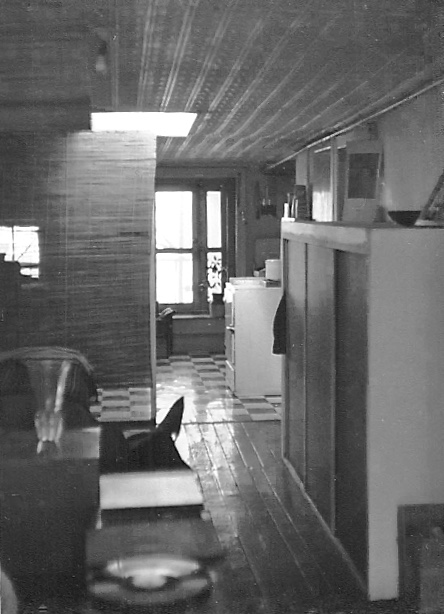
It was a perfect party space for the Beats as they were birthing in Manhattan in the late ’40s. As Holmes describes the officially non-residential / industrial Chelsea building in Go: Cannastra “lived in a drab district of warehouses, garment shops, and huge taxi garages. His loft was at the top of an ugly brownstone, unoccupied but for a lampshade factory on the second floor. … The loft itself was one of those floors-through with low windows, several grimy skylights that opened out on chimneys, and a sort of kitchen alcove at the back. It was always a fantastic litter of broken records, dusty bottles, mattresses, a slashed car seat, a few decrepit chairs from empty lots, and stray articles of ownerless clothing.”
Although John describes the skylights as “grimy” they were multiple and large, and Joan said, “Bill loved the light in the place,” as she made the decision to take over his lease and preserve it as he had it, becoming one of the “clandestine loft dwellers,” as she put it. Although, truth-be-told, with her & Jack being busy getting married in November, they never got around to working, so ended up moving out after just one month, and into Mémère’s house in Richmond Hill, Queens.
And in today’s installment of Eventful Times in World History — it was that very month (December 1950) that Jack would receive the “Joan Anderson – Cherry Mary letter” from Neal Cassady that would blow open his approach to writing.
Joan Haverty describes the famous loft in great detail in her confessional 10-years-in-the-works memoir of this period Nobody’s Wife (assembled posthumously & nobly by her half brother-in-law John Bower, which you can read about here) — “The loft was huge, sixty feet by maybe thirty feet at the front and back ends, but the center lost some width due to the stairwell, giving the whole apartment a squat U shape. There were no interior walls. Areas were designated by placement of the few pieces of furniture. The kitchen only gave an impression of being separated, because it was located at one end of the U. [the back] The center sleeping and sitting area was set apart from the kitchen and the large front studio [facing onto 21st St.] by waist-high storage cabinets, which extended into the room at right angles to the wall. Between the cabinets were a double bed, with a red spread, a small oak table, and a chair, which Bill and I had re-webbed and reupholstered in blue plush the previous winter.”
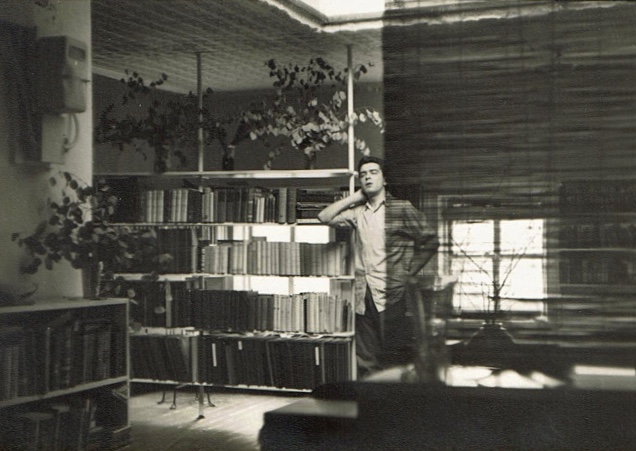
In late summer 1950 when Jack was living at Seymour Wise’s apartment around the corner at 24th & 9th Ave., no less than Lucien Carr moved into the same floor of the brownstone right next door! It was like a Beat sitcom!
Lucien moved into his girlfriend Liz Lehrman’s loft — just as Jack would soon move into Joan Haverty’s — example # 50,002 of how the women were the real anchors of this drunken Beats boys club. They had adjacent apartments in adjacent buildings — each architecturally identical both inside and out — with a partying badass beatnik & all his gone pals on whichever side of the wall you fell!
The two most famous (infamous) New York City deaths in Beat history — Lucien murdering David Kammerer and Bill’s tragic accident — were living right next to each other in that brief window of time between Lucien getting out of jail and Bill getting out of a subway.
Liz Lehrman, who later changed her name to Liza Williams, became a columnist for the L.A. Free Press, where she wrote her own firsthand memory of Bill’s tragic death.

Also — Bill’s loft is where Jack met his wife . . . and Lucien’s loft is where he went when he left her six months later.
And in a related story — Lucien’s is also where his dog Potchky chewed off the historic end of the historic tracing-paper-tasty scroll!
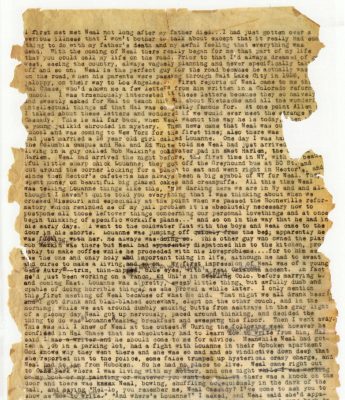
.
And speaking of paper! Oh my gawd! There has never been a piece of paper in all of history that’s been more talked about than Jack Kerouac’s original On The Road scroll — which sold at auction in 2001 for the most anyone ever paid for a literary manuscript — and it has been positively definitely definitively declared by different people to be everything from Japanese drawing paper to Chinese art paper to onionskin paper to teletype paper to glassine paper to wax paper to shelf lining paper. (!)
But, despite all the speculation and misidentification, for the eternal record, the On The Road scroll was typed on straight-up tracing paper.
The first time anyone in history ever referred to it in writing was just 5 days after Jack finished it in his 20-day spurt and had given it to his best novelist friend John Clellon Holmes to be the first to read it. Holmes wrote in his diary on April 27, 1951, “He wrote it in twenty days, and it is one long strip of tracing paper, one hundred and twenty feet long.”
The second time it was ever referred to in writing was a few weeks later on May 22nd when Jack himself wrote of it to his brother Neal to tell him he’d just finished writing his new masterwork — “Went fast because road is fast . . . wrote whole thing on a strip of paper 120 feet long (tracing paper that belonged to Cannastra.)”
And according to “the guardian of the scroll,” the world-renown manuscript preservationist Jim Canary, it is NOT “Japanese drawing paper” or “drawing paper” at all from Japan or anywhere else, but rather, as he specifically told me, “I have gotten samples of the same paper stock sold today to compare it to. It is more like a drafting tracing paper. It doesn’t seem to be like any Japanese drawing papers I have seen. I have a 1961 letter from [legendary Viking editor] Malcolm Cowley where he says Japanese drawing paper, too. I think many people see a very thin paper and assume Japanese drawing paper or rice paper even, though most Japanese paper is made of anything but rice — actually 3 main fibers, all inner bark of plants.”
.
And then there’s The Girl.
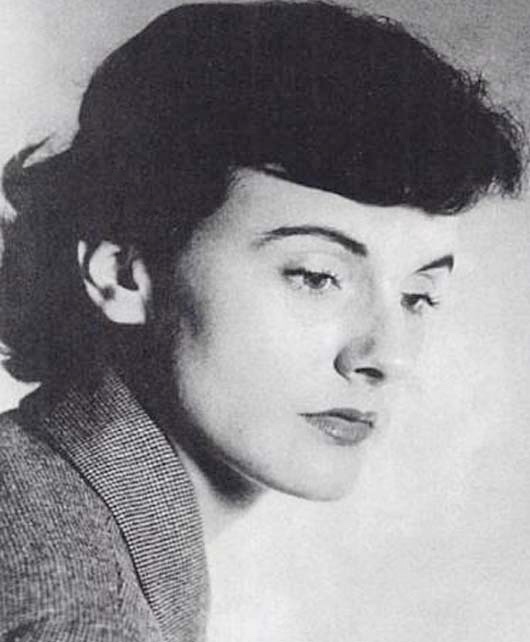
.
The Cannastra loft may have been famous for the days-long parties thrown there and the tracing paper salvaged after its resident’s passing, but it was also the treefort clubhouse for a curious and adventurous young woman from the suburbs of Albany when she relocated to exciting post-war New York City after an eye-opening summer at an artists’ retreat in Provincetown where she first met Bill who was working as a scallop fisherman on a boat.
She moved to Manhattan in the late summer of 1949 as an 18 year old into a shared Upper West Side apartment arranged by her mother, but spent most of her time with Bill on adventures in the Village. Although they were never really boyfriend-girlfriend, they never “did anything to contradict the widespread assumption we were lovers,” as she put it in her memoir. “He loved the drama and storminess of Cathy & Heathcliff [of Wuthering Heights fame, and in fact Bill took to playfully calling her ‘Cathy’] . . . he always acted as a big brother to me,” including advising she wait until marriage before having sex. She called him “my companion, confidant, buddy and playmate, commiserator and confirmer, affirmer, counselor and advisor, but never my judge, critic or reformer.”
A couple weeks after Bill’s death, when ol’ blue-eyes Jack came by and hollered up from the street on a night when neighbor Lucien was throwing a party (a scene captured at the start of Part Five of On The Road), she was fairly captivated by him from the jump — aided by the literal and literary foreshadowing of Bill having suggested him to her earlier. He told her he’d been trying to play matchmaker between the two but could never get them together at the same time. And when Jack had described his ideal woman to Bill, Bill told him it sounded like he was describing Joan perfectly.
Then add to the volatile mix of the half-century-year madness the sudden stone-cold death of the Wild Young Men’s matinee idol & edge-dancing maniac — plus Jack was approaching the dreaded 3-0 — suddenly settling down was in the air. But as Joan describes Jack’s approach, it was beyond unromantic to the point of being more of a practical job application for a replacement for his mother. He wanted a woman who could cook, sew, and keep their apartment clean while he went out in the world and did things to write about. For all the Beats’ being ahead of society’s curve on things like sexual & racial equality, psychotropic drug exploration, spontaneous art, celebrating the Real World, road trips, Bebop, Howling raps and freedom from corporate conformity — gender equality was not exactly their strong suit.
And boy that extended to monogamy. And Cannastra’s loft did not help matters! Not only was it there that Jack met and proposed to Joan while he was still married to his first wife Edie, it was at a Cannastra party (in late ’49) that Neal met and soon bigamously married his third wife Diana Hansen.
John Holmes was there the night of the meeting and described it rather brilliantly & vividly in his tribute to Neal that first appeared in Kesey & Babbs’ Spit In The Ocean Cassady tribute issue:
“… that night in Cannastra’s Caligari-loft, amid smashed records, empty bottles, 25 watt shadows, where sullen, end-of-the-world whoopees were hopelessly raised against the inevitability of hangover-dawn, [Neal] cottoned to a girl, Diana, somebody’s ex-wife, sojourning among the lost that year, who melted out of her midtown hauteur under his acetylene concentration, his laughing cajolery, wickedly raised brows, and roving hands through which the shoulder’s electricity pulsed with strange grace till she drowned in such attention, knees spread around him on a stained ticking, feeling a pierce of Western sun warm New York’s barren womb …”
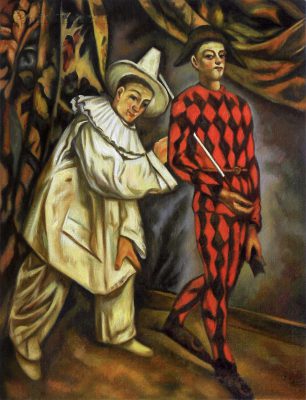
.
.
Another revelation from Joan’s memoir was the address of Bill’s historic loft. Like the widespread plethora of claims of the type of paper On The Road was written on, there’s never been more different addresses for a single apartment in the history of conspiracy theories! In Cannastra’s New York Times obituary and Al Aronowitz’s 1961 New York Post profile, it’s listed as 165 West 25th Street. At the first big Kerouac symposium at Salem State College in 1973, Allen said it was on 23rd Street. Joyce Johnson calls it 121 West 21st in her Voice Is All book. Even the Cannastra family long thought it was 165 West 21st St.
But by far the most common mistaken address is 125 West 21st. You see it everywhere. Problem is, 125 was not a brownstone; was not next door to Lucien’s; was 5 stories not 4; was fairly isolated in terms of fire escape roof traversing; there were no stairs up to the front door as Joan mentions at the end of chapter 7 (and every brownstone has); and the windows don’t match Holmes’ description or those in the now known loft photographs.
You can see the 125 building here, circa 1940 — (directly above the sign, car in front, white windowed second floor) —
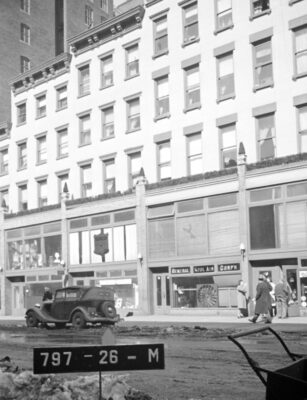
If anyone was really going to know, it was the person for whom the address meant the most — the person who had her best friend & mentor & big brother die horrifically when she was only 20-sponge-sucking-impressionable-years-old and who had been enticed to The Big City by him repeating the address to her over and over again — an address she went back to a thousand times in her first year in New York. Anyone who ever moved to the City remembers forever the addresses of the places they first felt “home.”
Plus it was the first apartment she actually moved into on her own in New York, and tried to preserve as a memorial to her fallen friend. Not to mention the place where her first husband met her and proposed to her. And all this by a person who has a memory for addresses and gets the other ones she mentions in her book correct and re-read the manuscript pages many times over — that woman remembers distinctly the address of the fulcrum of her life as being — 151 West 21st Street.
And as further corroboration, Joan describes vividly how their mutual friend Lucien Carr lived in the adjacent twin building next door, and were both on the same top floor to boot, and how the lights in their windows were in a line, and how they’d regularly visit each other by just scooching over the back fire escapes. Allen also talks about them living next door to each other in a letter of November 1950 to Neal Cassady (where a fluctuating Allen also confesses to pursuing Joan at Lucien’s prodding!) And if they were not in adjacent buildings, Jack’s own account of calling up from the street to Lucien’s party and Joan hearing him and throwing down the keys couldn’t have happened. And through all of this — Lucien’s address was . . . 149 West 21st.
You can see it here in 1940 (from the NYC Archives) — directly above the marker sign with the three square windows on the fourth floor that also appear in the loft photos. Lucien lived in the building to the right with the PRINTING sign out front.

.
And speaking of photos, this whole journey of discovery began with a photo! An entirely different one (!) that appears to be Allen Ginsberg, a well buzzed Jack Kerouac, and Neal Cassady — the first known photograph with all three in it — plus a fourth man that no one has been able to identify thus far.
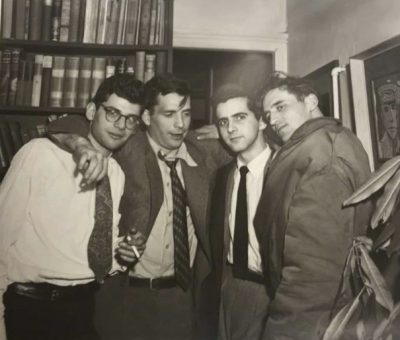
Nothing is known for sure about this photo, but after a lengthy colloquy among a wide range of Beat scholars and aficionados it seems to be the consensus that it was taken in New York between March and May 1950, when Kerouac’s first novel The Town and The City had just come out and he was making suit-wearing formal appearances as the aspiring rising young author, and when all three big Beat lights were burning bright in the big city.
Many speculated the mystery man was Bill Cannastra, which prompted both myself and The Beat Museum’s Jerry Cimino to try to track down any living member of his family who could weigh in definitively on the matter.
Turns out, we both found at almost the exact same time one of only two Cannastras of that generation still living! And it turned out she was extremely nice and cool and friendly and with-it and had a few pictures of her Uncle Bill that had never been seen outside the family. And she wanted to share them!
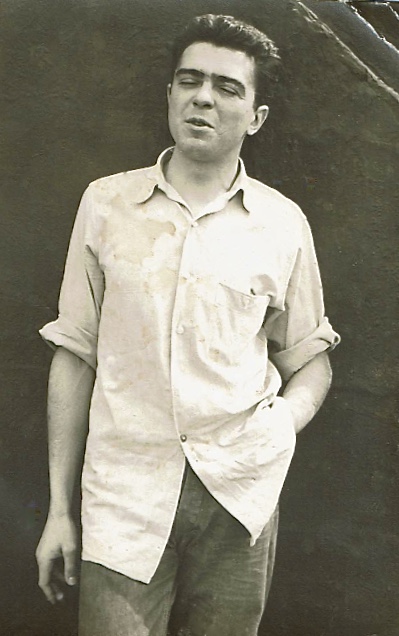
.
And this is the thing — her Uncle Bill was a frickin HUGE figure in the history of the world.
And yeah, that’s right. I said “world.”
It was Bill who set up Joan and Jack. And it was that (short-lived) relationship that gave Kerouac the temporary stability outside his mother’s house to have his creative breakthrough that changed history.
And not only that — but the very same guy who provided The Girl — also provided The Paper!
No way!
I know!
C’mon! Yer makin’ this up.
There’s no way!
Who is this guy? The Fonz?
The Cassady?
The catalyst?
One guy?
Who Lucien Carr moved in next to?!
What?!
Who partied with Jackson Pollock and Jack Kerouac?!
And Tennessee Williams and Dylan Thomas?!
The guy who was James Dean cool before there was a James Dean.
Had Elvis hair before there was an Elvis
Lived Gonzo before there was a Hunter Thompson.
.
Maybe just for a moment his time can come and somebody can say Yeah!
.

Note the bongos on the shelf. From a Nov. 28 1950 John Holmes letter to Neal Cassady about the afternoon of Jack’s wedding —
“Everyone was in a furor, the phone was ringing continually, Jack would rush from shaving to the bongos (Cannastra’s old bongos) to accompany some wild Mambo that poured out of the radio.”
.
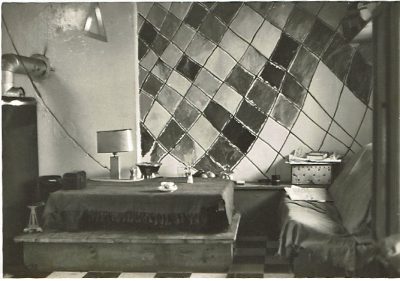
.
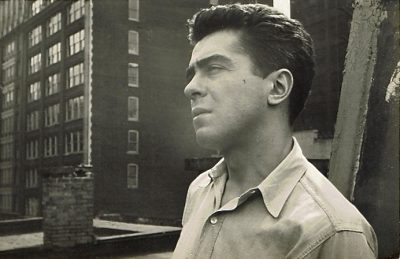
.
.
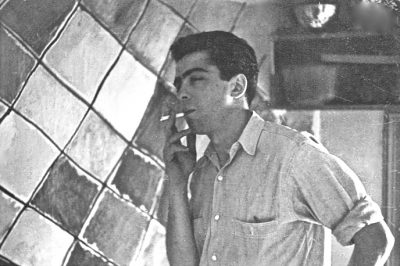
.
Quick Historical Clarification —
You always see it writ that ol’ Bill went out on the town on Oct. 12th and darned if he didn’t die.
Well, fact is, he went out on the evening of Wednesday (of all days of the week!) October 11th for the carousing activities that led to an unfortunate moment on a subway — but the point is — he died a few minutes into the 12th. The obit was in the Times the morning of the 13th. There’s a Rashomon of accounts of what happened on that subway car, but time was running linearly, and he was out on a Wednesday night the 11th being bad, so just leave Thursday right out of it.
.
Here’s an excellent video of the NYC subway in action in 1949.
At the 4:00 mark there’s a good view of open windows.
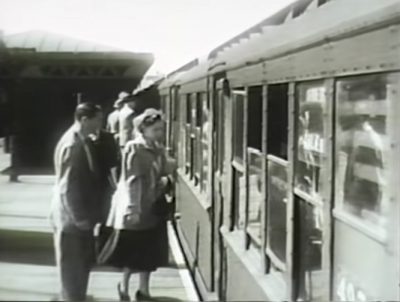
.
.
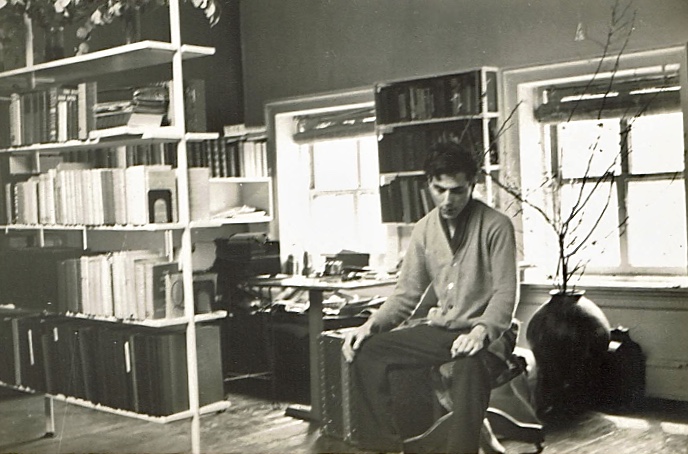
the “low windows” that you can also see are exactly the same
from the outside in the New York City archive photos linked above.
.
Double Bonus Hysterical Clarification —
How did you always pronounce “Cannastra” in your head (or out your mouth)? I always said it and heard it like the card game “Canasta.”
But in fact the family actually pronounces it more like “canister” … Cann-i-stra.
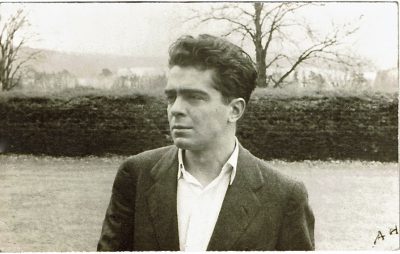
.
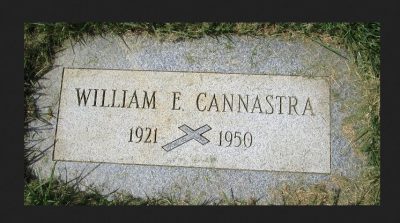
.
Photos reprinted by permission of the Cannastra family.
===============================================
.
For more riffs n fun n stuff like this . . .
There’s The Hitchhiker’s Guide to Jack Kerouac about a whole Adventure to that biggest Beat gathering ever in Boulder in ’82 (that Jan’s at above) . . .
Or there’s the one about How The Beats Begat The Pranksters that brings a whole buncha crazy worlds together . . .
Or there’s the most recent On The Road with Cassadys that’s just what you’d imagine . . .
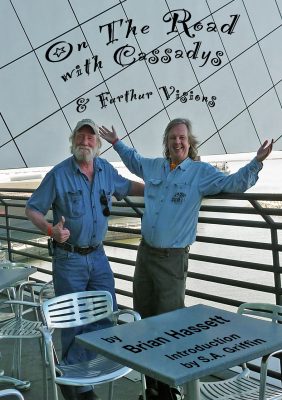
And if you like Adventures and rock n roll you’ll love Holy Cats! Dream-Catching at Woodstock . . . 😉
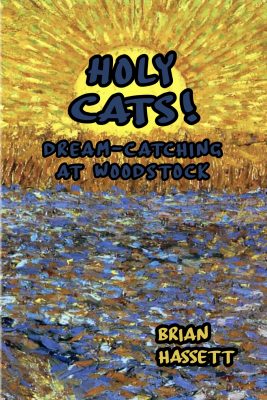
===============================================
by Brian Hassett — karmacoupon@gmail.com — BrianHassett.com
Or here’s my Facebook account if you wanna join in there —
https://www.facebook.com/Brian.Hassett.Canada

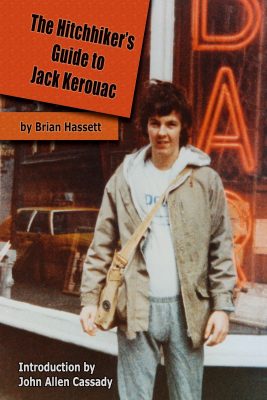
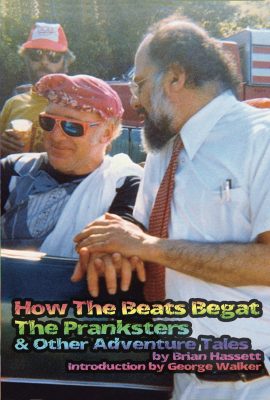
37 responses so far ↓
1 Jerry Cimino // Apr 21, 2019 at 9:07 AM
This is un-freaking-believable! You sure have a way with words. So cogent and effortless and reads so easy and flows so smoothly.
You’re bringing a lot of history together along with a lot of gee whiz detail most people have never considered. I like you’re quoting Joan a lot, and Canary, too.
This is a groundbreaking piece of scholarship, Brian!
2 Steve Silberman // Apr 21, 2019 at 9:33 AM
This is fascinating!
3 Simon Warner // Apr 21, 2019 at 9:41 AM
A red hot shot of literary lightning. Amazing what secrets the past buries in its shadowy folds.
4 Brian Humniski // Apr 21, 2019 at 9:50 AM
Revealing read. You have me reconsidering the place of one Kerouac’s “mad ones,” Bill Cannastra. Your quest to disclose the name behind the face in a resurfaced picture has taken you to a totally new and undiscovered place. The photos included are awesome and give us a real glimpse into the Beat scene of 1950. He was so much more than that guy who died on a subway one night. He moved and shook the world in his own way.
5 Bob Jones // Apr 21, 2019 at 9:57 AM
Yup…What Jerry said…you do have a way with words …. and an excellent bit of investigative journalism and scholarship. It’s great to have some clarity on the little mysteries of the Beat history. Thanks, Brian.
6 Carolyn Riesbeck Kerouac // Apr 21, 2019 at 10:35 AM
Unbelievable! Great information here! ❤️
7 Gubba // Apr 21, 2019 at 11:02 AM
Whoa! What a story! What Sleuthing!
Only the facts, man!
Yeah but only the pieces that fit with each other,
And only where the glue actually sticks!
Lot of folks wrote a lot of stuff …
But you actually pulled it together
In a big drag net!
And hey! (you say) I just happen to have a photograph…
(that nobody’s ever seen!)
That shows exactly what those folks were talking about!
And what a guy!
James Dean cool before there was a James Dean!
Elvis hair before there was an Elvis!
Lived Gonzo before there was a Hunter Thompson!
All true! Way before, then gonzo gone! In a heartbeat!
Want some icing for your cake?
Try Cezanne’s ‘Mardi Gras’ as Kerouac looks up!
A coup, Brian … a coup. Thank you.
8 Marc Eliot Stein / Levi Asher // Apr 21, 2019 at 11:17 AM
Really enjoyed this. Also for what it’s worth Finistra is also a cool pun on “fenestra” which means window and is often used in operas when a characters is serenading a woman at her window – a seductive connotation – and yes, he cleverly twisted it to add “finis”
9 Jeanne Masanz // Apr 21, 2019 at 11:32 AM
Wow, you made my day!
10 Pamela Twining // Apr 21, 2019 at 12:02 PM
Great research, Brian! Super Interesting!
11 Will Combs // Apr 21, 2019 at 1:31 PM
Excellent scholarship, well thawed out.
The first beat was a Heartbeat. Good to see the early dots connected.
12 Michael Sharp // Apr 21, 2019 at 9:55 PM
Very interesting – and some great photographs.
13 Tom Hardin // Apr 22, 2019 at 9:49 AM
Awesome piece!
14 Ranger Will // Apr 22, 2019 at 9:57 AM
It’s so great to see a photo of Neal Cassady that I had never seen before! Thanks!
15 Philip E. Thomas // Apr 22, 2019 at 10:17 AM
Just wow.
16 Jason Pacheco // Apr 22, 2019 at 1:32 PM
So awesome! ❤️
17 Phil Linz // Apr 22, 2019 at 2:51 PM
Great discovery!
18 Marc Zegans // Apr 22, 2019 at 4:20 PM
Great read, Brian!
19 Jeanne Young // Apr 22, 2019 at 4:34 PM
This is great Brian ~ really enjoyed reading!
20 Yano Harris // Apr 22, 2019 at 5:02 PM
That’s history. It needs to be recorded. Thanks, brother.
21 Michael D. Shulman // Apr 23, 2019 at 7:03 PM
This is fantastic, and so well written, Brian! My old office was at 151 West 25th, so I felt the vibrations a few blocks away and many decades later.
22 Ken Morris // Apr 23, 2019 at 8:11 PM
Super, Jester!! This piece ranks with your best stuff. Period.
October is some kinda portal. Damn!!
23 Gubba // Apr 23, 2019 at 10:39 PM
Ken — its the end of the land sadness end of the world gladness in the railroad earth!
24 Michael Sharp // Apr 24, 2019 at 9:42 AM
Very interesting – and some great photographs.
25 Kathryn Streletzky // May 9, 2019 at 3:18 AM
Hal Chase – 4th guy in the photo? He knew Cassady in Denver and introduced Neal to the crowd at Columbia.
26 justine allison // May 15, 2019 at 10:28 PM
This is great!
27 Bill Clinton // Aug 9, 2019 at 7:16 AM
We still don’t know who the mystery man is in the picture with Allen, Jack and Neal. Sure ain’t Bill Cannastra.
28 Dale Topham // Aug 29, 2019 at 1:34 PM
Thanks Brian. You did incredible research on this one! It’s a great story!
29 Alex Cooke // Sep 24, 2019 at 9:14 AM
What a great read! Thank you, Brian.
30 Tom O'Shea // Sep 24, 2019 at 2:27 PM
This piece was written with a concise style that I had not seen from your pen, till now.
Scholarly, in a way. And decidedly reverent.
What is always evident is your enthusiasm for whatever you are reporting. It transfers w/
little effort. Now enhanced with a depth of research worthy of an NYU grad school project.
31 Ken Morris // Sep 24, 2019 at 6:22 PM
Cannastra is truly more than just a footnote. His networked contacts reads like a who’s who of 20th c. Art & Lit. Great work, Brian.
32 Anna Wyrwik // Sep 24, 2019 at 8:24 PM
Thanks!
33 Jim Pennington // Sep 24, 2019 at 11:51 PM
Exciting to read this … made me feel I was right there.
That “plus a fourth man” … is he possibly the same as the one in that moody shot described as “Someone (not Bill) sitting in the front lit “studio” workspace ” ?
That photo with the unidentified 4th person has a painting in the background at the right … anyone recognize it? It looks, dare I say, very very cool and ’50s — where else would it be but in a very very cool open-zen-planned live/work space.
34 Brian // Sep 25, 2019 at 9:19 AM
Jim — The unidentified guy in the loft photo was someone Bill knew — and when I ran the two photos by the family they didn’t think it was the same person.
The mystery of who both men are remains unsolved.
35 Cliff Bellamy // Sep 25, 2019 at 10:51 AM
A great piece of history — thanks for writing this.
36 Rob Stowell // Nov 23, 2019 at 4:13 AM
Wow. Great to see these pics and stories. Been reading Nobody’s Wife and curious about Bill cos I have a collection of letters he wrote to my father, in 43-44 when they were both at Harvard. Wild Bill indeed! Must get onto scanning the letters. Thanks for this.
37 Peter Hayes // Jan 10, 2022 at 7:53 PM
Robert Stowell I would love to see that collection of letters!
Leave a Comment